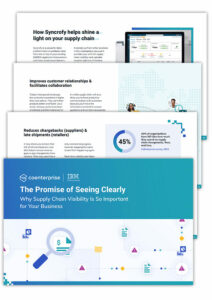
As a business, getting to market faster means getting to revenue faster. But outdated electronic data interchange (EDI) connections can slow down your supply chain communication, costing you time, money and opportunities.
Electronic data interchange (EDI) has been the standard for B2B supply chain communication since the 1960s and early 1970s, but it’s time for an upgrade. Traditional EDI connections are complex, brittle, and take too long to implement, resulting in companies spending thousands of dollars and weeks or even months to onboard new partners.
Imagine if you could establish a connection to a modern EDI trading network and could start testing immediately and be live in days rather than weeks or months.
Here are the top three reasons enterprises should be thinking about modernizing their EDI infrastructure:
1. It’s costly and time consuming to build custom, point-to-point integrations.
Large companies, with enormous leverage in terms of buying power, tend to create their own EDI guidelines and then mandate that their smaller trading partners implement EDI according to those specifications. That means a small company must now build custom solutions to work with multiple trading partners.
It’s not uncommon to find companies are spending thousands of dollars upfront to build an EDI integration to a new customer or partner, prior to even being able to monetize that relationship. If it takes 12 weeks and thousands of dollars before they go live, that means they have sunk a lot of costs into the relationship before knowing if they will ever recoup the costs. On both sides of the equation, this is an inefficient, expensive and time-consuming process.
To address this challenge, a centralized network can be used to consolidate all the requirements from potential partners to a single integration point using modern APIs. This eliminates the need for custom solutions for each partner and allows companies to trade with all of their partners via a cloud-based solution. As a result, when a small company needs to add a new partner, it sends data into the network where its partner’s requirements already exist, and the network will automatically transform it into the correct format for the receiving partner before being sent onward. This saves time, reduces costs, and improves efficiency for all parties involved.
2. It takes weeks of back and forth to validate and test integrations.
Smaller trading partners often face the issue of prospective clients refusing to engage with them unless they have EDI capabilities. Therefore, building and testing these connections is a must-have. However, because custom integrations are built against written requirements, they require weeks of manual testing and validation. This involves manually sending test transactions via e-mail and having them manually validated. The process of confirming that the typical half-dozen transactions used in any relationship will be accepted can take weeks.
By utilizing a digitized, pre-connected network, data can be validated in real time against actual requirements, shortening the testing cycle and ensuring only valid transactions are sent between partners. This streamlines and automates the entire process, saving precious time and resources.
3. Trading partners lack the control that allows them to resolve issues in a timely manner.
Changes in business and systems can have a significant impact on the supply chain. If a company decides to modify their back-end system (ERP, TMS, WMS), it can create problems for their trading partners. Transactions that previously worked can suddenly fail, causing confusion and delays. Since custom-built connections often lack user interfaces and reporting tools, identifying the root cause of these errors can be a daunting task that takes weeks to resolve.
Being able to quickly identify issues, troubleshoot them in real time, and keep the business connections running smoothly is absolutely key. Currently, many who outsource the service don’t know for days or weeks when transactions have failed. Worse, they have no way to troubleshoot and fix them by themselves; they have to file support tickets and wait. Having full visibility and self-service tools is a proven and major benefit for business partners.
With a pre-connected, smart network, the transactions can be viewed in real time, errors can quickly be identified, and changes can be made in the system — by the user — via simple point-and-click tools.
How Orderful Makes EDI Faster and Easier
Orderful’s Modern EDI Platform transforms EDI by allowing companies to quickly integrate their enterprise applications with a pre-connected network of trading partners using an easy-to-use canonical API. The platform electronically publishes the requirements of supply chain organizations, consolidating the EDI requirements of all partners into a single payload structure for each transaction. It automatically converts, validates and communicates data to ensure it meets the unique requirements of the receivers.
With an intuitive UI, Orderful provides users with full visibility and control over all transactions, allowing them to identify and resolve issues in real time. With pre-built testing scenarios and a point-and-click rules engine, it simplifies testing and enables companies to go live in under nine days instead of the typical 12 weeks.
Orderful’s ultimate goal is to reduce this time even further to nine minutes, and eventually, nine seconds.
Orderful’s Modern EDI Platform is the solution for companies seeking to modernize their EDI infrastructure and get to market faster with reliable and easy-to-use EDI infrastructure.
Resource Link: www.orderful.com
- SEO Powered Content & PR Distribution. Get Amplified Today.
- Platoblockchain. Web3 Metaverse Intelligence. Knowledge Amplified. Access Here.
- Minting the Future w Adryenn Ashley. Access Here.
- Source: https://www.supplychainbrain.com/articles/37038-three-reasons-to-modernize-edi-infrastructure
- :has
- :is
- :not
- a
- Able
- About
- absolutely
- According
- address
- against
- All
- All Transactions
- Allowing
- allows
- already
- an
- and
- any
- api
- APIs
- applications
- ARE
- AS
- automates
- automatically
- B2B
- back
- Back-end
- BE
- because
- been
- before
- being
- benefit
- between
- both
- Both Sides
- build
- Building
- built
- business
- Buying
- by
- CAN
- capabilities
- Cause
- causing
- centralized
- chain
- challenge
- Changes
- clients
- Communication
- Companies
- company
- complex
- confusion
- connection
- Connections
- consolidate
- consolidating
- control
- Costs
- could
- create
- Currently
- custom
- Custom-built
- customer
- cycle
- data
- Days
- delays
- digitized
- dollars
- don
- down
- each
- Early
- easier
- easy-to-use
- efficiency
- Electronic
- electronically
- eliminates
- enables
- engage
- Engine
- enormous
- ensure
- ensuring
- Enterprise
- enterprises
- Entire
- ERP
- Errors
- establish
- Even
- eventually
- EVER
- expensive
- Face
- FAIL
- Failed
- faster
- File
- Find
- Fix
- For
- format
- from
- full
- further
- get
- getting
- Go
- goal
- guidelines
- Have
- having
- However
- HTTPS
- ID
- identified
- identify
- identifying
- immediately
- Impact
- implement
- improves
- in
- inefficient
- Infrastructure
- instead
- integrate
- integration
- integrations
- interfaces
- into
- intuitive
- involved
- issue
- issues
- IT
- ITS
- jpg
- Keep
- Key
- Know
- Knowing
- Lack
- Leverage
- LINK
- live
- Long
- Lot
- made
- major
- MAKES
- mandate
- manner
- manual
- manually
- many
- Market
- means
- Meets
- minutes
- Modern
- modernize
- modify
- monetize
- money
- months
- multiple
- Must-Have
- Need
- needs
- network
- New
- now
- of
- on
- Onboard
- only
- opportunities
- or
- organizations
- outsource
- over
- own
- parties
- partner
- partners
- platform
- plato
- Plato Data Intelligence
- PlatoData
- Point
- potential
- power
- Precious
- previously
- Prior
- problems
- process
- prospective
- proven
- provides
- Publishes
- quickly
- rather
- real
- real-time
- reasons
- receiving
- reduce
- reduces
- refusing
- relationship
- reliable
- Reporting
- require
- Requirements
- Resources
- result
- resulting
- revenue
- root
- rules
- running
- s
- saving
- scenarios
- seconds
- seeking
- Self-service
- sending
- service
- should
- Sides
- significant
- Simple
- since
- single
- slow
- small
- smaller
- smart
- smoothly
- solution
- Solutions
- specifications
- Spending
- standard
- start
- structure
- supply
- supply chain
- support
- system
- Systems
- Take
- takes
- Task
- terms
- test
- Testing
- than
- that
- The
- their
- Them
- themselves
- therefore
- These
- Thinking
- this
- thousands
- three
- tickets
- time
- time-consuming
- to
- too
- tools
- top
- trade
- Trading
- traditional
- transaction
- Transactions
- Transform
- typical
- ui
- ultimate
- Uncommon
- under
- unique
- upgrade
- used
- User
- users
- Utilizing
- VALIDATE
- validated
- validation
- via
- visibility
- wait
- Way..
- Weeks
- WHO
- will
- with
- WMS
- Work
- worked
- written
- you
- Your
- zephyrnet












